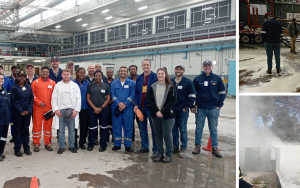
Prof John Babafemi paves the way for sustainable concrete
- Prof John Babafemi from the Department of Civil Engineering delivered his inaugural lecture on Tuesday 14 October 2025.
- His research focuses on developing and testing sustainable concrete.
- He promotes material efficiency and environmental sustainability in the cement and concrete sector.
Prof John Babafemi from the Department of Civil Engineering in the Faculty of Engineering at Stellenbosch University delivered his inaugural lecture on Tuesday 14 October 2025. The title of his lecture was “Sustainable concrete: exploring its breadth, length, depth and height”.
Babafemi spoke to the Corporate Communication and Marketing Division about how he helps to promote material efficiency and environmental sustainability in the construction industry, particularly in the cement and concrete sector.
Tell us more about your research and why you became interested in this specific field.
I am passionate about developing and testing sustainable concrete that incorporates low-carbon binders (materials used to hold the ingredients of concrete together) and alternative or non-conventional aggregates (materials used instead of the usual sand and stone in concrete). With global concrete consumption exceeding 40 billion tonnes annually, reducing its carbon footprint is critical.
My research seeks to advance circular economy practices (ways of reducing waste by reusing, recycling, and designing products to last longer) in concrete production, promoting material efficiency and environmental sustainability to help the construction industry achieve the global net zero emissions target by 2050.
How would you describe the relevance of your work?
The construction industry, particularly the cement and concrete sector, is responsible for approximately 8% of human-made CO2 emissions globally, with the attendant impact of global warming. My research is relevant as it addresses the urgent need to lower emissions through the substitution of conventional materials with more environmentally friendly materials and waste valorisation (turning waste into something useful, like recycling it into new products, reusing it, or converting it into energy). Hence, promoting circular economy principles, enhancing resource efficiency, contributing to achieving the global net zero targets, and ensuring sustainable infrastructure development for future generations.
Can you give examples of how your research is applied in real-world contexts?
Low-carbon binders and alternative aggregates have real-world applications in various concrete products. I am collaborating with the industry, where there is already an update on conventional low-carbon binders, such as slag (a leftover material from making steel), fly ash (a fine powder that is left over when coal is burned in power plants), silica fume (an extremely fine powder created during the production of silicon or steel alloys), and calcined clay (clay that has been heated to a high temperature so it can be used in concrete instead of some cements), as a partial substitute for Portland cement – the most common type of cement used as a key ingredient in concrete.
Additionally, eco-aggregate made from recycled plastic waste is being incorporated into pavers, concrete hollow blocks, kerbs, and concrete barriers, among other applications.
What does it mean when we talk about sustainable concrete?
Sustainable concrete is designed and produced to minimise embodied carbon, conserve natural resources, enhance performance, and improve energy and water efficiency throughout its life cycle. It also promotes circularity and aligns with broader social and economic sustainability goals.
What steps can the construction industry take to make sustainable concrete a reality?
While the construction industry is already adopting conventional low-carbon binders, attention should now shift toward limestone calcined clay cement and other non-conventional binders. Additionally, alternative aggregates and energy sources, efficient design, construction and material use must be pursued more vigorously.
Looking into your crystal ball, what developments do you see in your field?
The uptake of alternative concrete types for construction, such as geopolymer concrete (zero Portland cement) and 3D-printed concrete.
The higher education environment can be challenging. What keeps you motivated when things get tough?
Passion and a love for what I do – teach, conduct research, and serve administratively.
Tell us something exciting about yourself that people would not expect.
Though I was brought up by a tough military man, I am tender-hearted and compassionate.
How do you spend your free time?
Resting, and listening to the news and online sermons.



